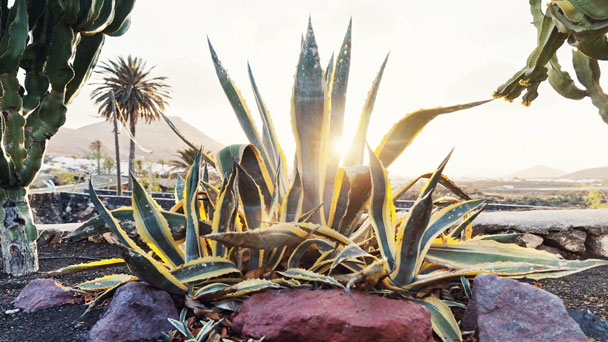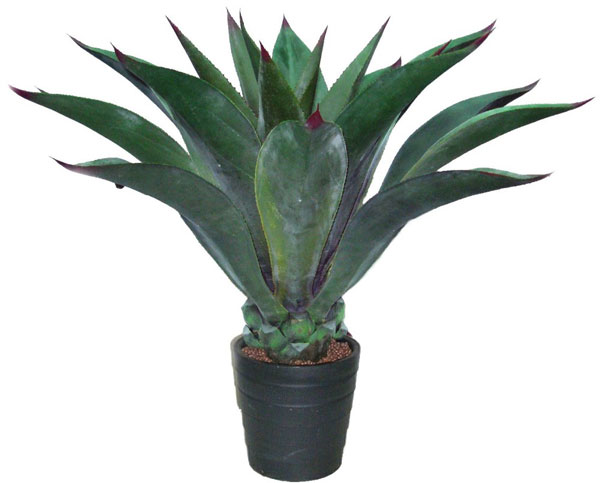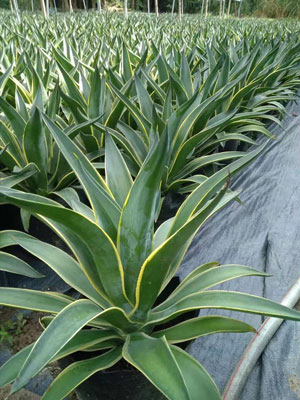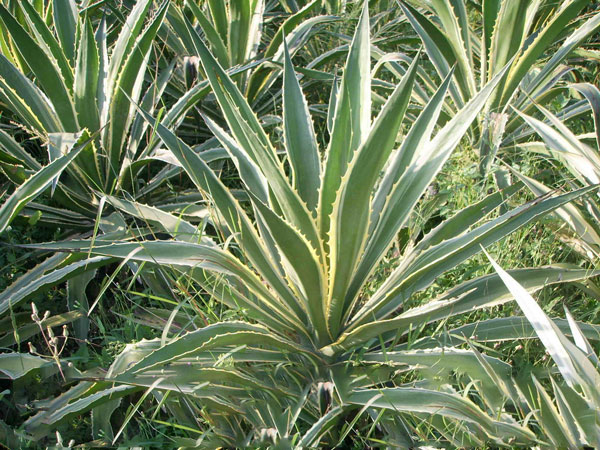Queen Victoria Agave (Agave Victoriae Reginae) Grow & Care Guide
Written by Iris
Nov 18 2021

Queen Victoria Agave (Agave Victoriae Reginae) was named in honor of Queen Victoria. Because the leaves of Queen Victoria agave are like arrows, the edges of the leaves are white markings, which look like snow deposited on the leaves. Queen Victoria Agave was originally grown in Mexico. The whole shape will grow very evenly, and the leaves will grow very compact. The whole shape is like a rosette, with spikes on the tips of the leaves. Usually, we can only see it in some botanical gardens, but few people can keep it well, because it prefers places that are warm and dry all year round.

We aren't talking about propagating by cuttings, so you don't have to use any rooting hormone and then have to worry about whether or not a cutting will take because you're basically extracting an already whole plant, the pup, from the mother plant and transplanting it.
So long as you’re careful with the roots and then give it appropriate soil and water (not too much), your newly transplanted agave should establish itself just fine.
Growing Queen Victoria Agave in containers also allows you move them outside during spring and summer and back indoors over autumn and winter, you also have the benefit of restricting its growth, the Queen Victoria Agave will still produce offsets when grown in a container, it's overall size just won't be as big.

Queen Victoria Agave Care Quick InfoWhere to Grow Queen Victoria AgaveHow to Grow Queen Victoria AgaveQueen Victoria Agave Propagation with SeedsQueen Victoria Agave Propagation with Stem CuttingsQueen Victoria Agave Propagation with OffsetsHow to Care for Queen Victoria AgaveQueen Victoria Agave Light CareQueen Victoria Agave Soil CareQueen Victoria Agave WateringQueen Victoria Agave Temperature & Humidity CareQueen Victoria Agave Fertilizer CareQueen Victoria Agave FAQsIs Queen Victoria Agave toxic to people, kids, pets?Is Queen Victoria Agave Considered Invasive?Will Queen Victoria Agave die after its flowers?How big does a Queen Victoria Agave get?
Queen Victoria Agave Care Quick Info
| Botanical/Scientific Name | Agave Victoriae Reginae |
| Common Name | Queen Victoria Agave |
| Uses | Used for fiber or food |
| Origin | Coahuila, and south of Nuevo Leon |
| Light Care | Plenty of full sun or light shade |
| Soil Care | Sharply well-drained succulent soil |
| Temperature Care | Low as 10 to 50 °F (-12.2 to 10 °C) |
| Humidity Care | Medium moisture |
| Watering | Watered sparingly |
| Pruning Care | No pruning required |
| Fertilizer Care | Organic fertilizers |
| Propagation | Cuttings |
| Toxic | Not toxic to humans |
| Flower Color | Creamy white and tinged with a red or purple |
Where to Grow Queen Victoria Agave
Queen Victoria Agave is not cold-hardy, so if you live in a zone that gets colder than 20° F (-6.7° C), it's best to plant this succulent in a container that can be brought indoors and placed under a grow light in the colder months. It does well in full sun. Plant in an area of your garden that gets 6 hours of sunlight a day.
How to Grow Queen Victoria Agave
Queen Victoria Agave Propagation with Seeds
Seeds can be collected from the flowers of the Queen victoria agave plant. Sow your seeds in well-draining soil. You can grow Agave seeds outdoors if you live in a zone above 9a. If you live in a cooler area, you can begin sowing indoors under a grow light or on a seed mat.Queen Victoria Agave Propagation with Stem Cuttings
The best way to grow Queen Victoria Agave from cuttings is by using either sterile scissors or a sharp knife. Start by removing the stem from the core of the plant, let the plant sit and harden for a few days. Once that is done, place the stem in well-draining soil, only water the plant if the soil has been dried out.Queen Victoria Agave Propagation with Offsets
Queen Victoria Agave and other plants that produce clone offshoots or pups are very easy and rewarding to divide and transplant. You can make your gardening budget go further with a little effort and patience by including them in your garden design.We aren't talking about propagating by cuttings, so you don't have to use any rooting hormone and then have to worry about whether or not a cutting will take because you're basically extracting an already whole plant, the pup, from the mother plant and transplanting it.
So long as you’re careful with the roots and then give it appropriate soil and water (not too much), your newly transplanted agave should establish itself just fine.

How to Care for Queen Victoria Agave
Queen Victoria Agave Light Care
Well, let's just say that if queen victoria agave was able to do that, it would spend all its time sunbathing catching those rays. This plant originated from Mexico and Southern USA. Therefore they require a minimum of 6 hours of direct sunlightQueen Victoria Agave Soil Care
- Growing Queen Victoria Agave in containers
- 1 ½ bucket of soil
- 1 bucket of sand
- ½ bucket of perlite
Growing Queen Victoria Agave in containers also allows you move them outside during spring and summer and back indoors over autumn and winter, you also have the benefit of restricting its growth, the Queen Victoria Agave will still produce offsets when grown in a container, it's overall size just won't be as big.
- Growing Queen Victoria Agave outdoors:

Queen Victoria Agave Watering
Queen Victoria Agave plant is well adapted to all parts of the Inland Empire in sunny exposures with normal winter rains and low amounts of summer irrigation. The chart shown below provides a recommended baseline guide to the monthly irrigation schedule and volume of supplemental water needed to maintain healthy growth throughout the average year. It should be noted there are several months indicated by an asterisk (*) when winter rains often provide sufficient moisture and irrigation is not needed. The high and low range of moisture indicates Queen Victoria agave can grow with varying amounts of water; little supplemental water is needed during summer.Queen Victoria Agave Temperature & Humidity Care
The Queen Victoria Agave is a great choice for those that would like to grow succulents outdoors for most or even all of the year. Although the species prefers temperatures above freezing (0 °C) year-round, it can deal with light frost as long as its soil is kept dry. In climates that get a lot of rain and/or frost during wintertime, you might want to move your Queen Victoria agave indoors during the harshest months.Queen Victoria Agave Fertilizer Care
Apply decayed thin liquid or compound fertilizer every 10 days or so.
Queen Victoria Agave FAQs
Is Queen Victoria Agave toxic to people, kids, pets?
Take care to place your agave out of the reach of pets and children because the sap may be irritating, and the terminal spines on each leaf can cause injuries.Is Queen Victoria Agave Considered Invasive?
This slow-growing plant is dependent on very specific environmental conditions and is not considered invasive.Will Queen Victoria Agave die after its flowers?
tall during mid-summer. This species dies after it flowers. Queen Victoria Agave is native to parts of central Mexico where it is now in danger of extinction. In contrast, it is widely cultivated to meet the demand for ornamental plantings in residential and commercial landscapes.How big does a Queen Victoria Agave get?
Queen Victoria Agave can get one to two feet tall. This rare, striking agave, named for Queen Victoria in England, forms a small, symmetrical, rosette of dark green foliage with white markings on the side of its toothless leaves. A sharp spine is apparent on the end of each leaf. It grows slowly to one to two feet tall and spreads eighteen inches wide.Latest Updated
- Benefits of Bugleweed - 7 Science-backed Health Benefits
- Bugleweed Dangers & Side Effects - Is It Poisonous?
- How to Plant Evergreen Trees - What You Should Know
- When to Plant Evergreens - Grow Guide for Evergreen Trees
- 12 Wonderful Evergreen Shrubs for Your Garden
- 12 Popular Evergreen Plants with Pictures for Beginners
- When And How To Prune A Lilac Bush Like a Pro
- How to Grow & Care for Lilac Vine (Hardenbergia Violacea)
- Japanese Lilac Tree (Syringa Reticulata) Care & Propagation Guide
- Shumard Oak Pros and Cons - What to Know
Popular Articles
- Winter maintenance of Antirrhinum Majus
- How to Grow Terminalia Mantaly Tree
- How to Grow and Care for Crossostephium Chinense
- How to grow Antirrhinum Majus in spring
- Peristeria Elata (Dove Orchid) Profile: Info & Care Guide
- Underwatered Snake Plant (Sansevieria Trifasciata) - Signs And How To Fix
- How to Care for Brazilian Jasmine Plant (Mandevilla Sanderi)
- How to Grow & Care for Graptopetalum Purple Delight in Summer
- Rosa Chinensis (China Rose): Plant Growing & Care Tips
- How to Care for Baby Sun Rose (Aptenia Cordifolia)